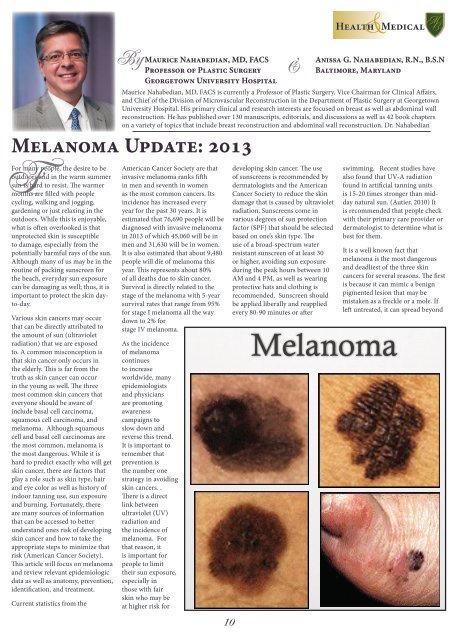The Chesterfield
Create successful ePaper yourself
Turn your PDF publications into a flip-book with our unique Google optimized e-Paper software.
&<br />
Health Medical M C<br />
For many people, the desire to be<br />
outdoors and in the warm summer<br />
sun is hard to resist. <strong>The</strong> warmer<br />
months are filled with people<br />
cycling, walking and jogging,<br />
gardening or just relaxing in the<br />
outdoors. While this is enjoyable,<br />
what is often overlooked is that<br />
unprotected skin is susceptible<br />
to damage, especially from the<br />
potentially harmful rays of the sun.<br />
Although many of us may be in the<br />
routine of packing sunscreen for<br />
the beach, everyday sun exposure<br />
can be damaging as well; thus, it is<br />
important to protect the skin dayto-day.<br />
Various skin cancers may occur<br />
that can be directly attributed to<br />
the amount of sun (ultraviolet<br />
radiation) that we are exposed<br />
to. A common misconception is<br />
that skin cancer only occurs in<br />
the elderly. This is far from the<br />
truth as skin cancer can occur<br />
in the young as well. <strong>The</strong> three<br />
most common skin cancers that<br />
everyone should be aware of<br />
include basal cell carcinoma,<br />
squamous cell carcinoma, and<br />
melanoma. Although squamous<br />
cell and basal cell carcinomas are<br />
the most common, melanoma is<br />
the most dangerous. While it is<br />
hard to predict exactly who will get<br />
skin cancer, there are factors that<br />
play a role such as skin type, hair<br />
and eye color as well as history of<br />
indoor tanning use, sun exposure<br />
and burning. Fortunately, there<br />
are many sources of information<br />
that can be accessed to better<br />
understand ones risk of developing<br />
skin cancer and how to take the<br />
appropriate steps to minimize that<br />
risk (American Cancer Society).<br />
This article will focus on melanoma<br />
and review relevant epidemiologic<br />
data as well as anatomy, prevention,<br />
identification, and treatment.<br />
Current statistics from the<br />
By<br />
Maurice Nahabedian, MD, FACS<br />
Professor of Plastic Surgery<br />
Georgetown University Hospital<br />
Maurice Nahabedian, MD, FACS is currently a Professor of Plastic Surgery, Vice Chairman for Clinical Affairs,<br />
and Chief of the Division of Microvascular Reconstruction in the Department of Plastic Surgery at Georgetown<br />
University Hospital. His primary clinical and research interests are focused on breast as well as abdominal wall<br />
reconstruction. He has published over 130 manuscripts, editorials, and discussions as well as 42 book chapters<br />
on a variety of topics that include breast reconstruction and abdominal wall reconstruction. Dr. Nahabedian<br />
Melanoma Update: 2013<br />
American Cancer Society are that<br />
invasive melanoma ranks fifth<br />
in men and seventh in women<br />
as the most common cancers. Its<br />
incidence has increased every<br />
year for the past 30 years. It is<br />
estimated that 76,690 people will be<br />
diagnosed with invasive melanoma<br />
in 2013 of which 45,060 will be in<br />
men and 31,630 will be in women.<br />
It is also estimated that about 9,480<br />
people will die of melanoma this<br />
year. This represents about 80%<br />
of all deaths due to skin cancer.<br />
Survival is directly related to the<br />
stage of the melanoma with 5-year<br />
survival rates that range from 95%<br />
for stage I melanoma all the way<br />
down to 2% for<br />
stage IV melanoma.<br />
As the incidence<br />
of melanoma<br />
continues<br />
to increase<br />
worldwide, many<br />
epidemiologists<br />
and physicians<br />
are promoting<br />
awareness<br />
campaigns to<br />
slow down and<br />
reverse this trend.<br />
It is important to<br />
remember that<br />
prevention is<br />
the number one<br />
strategy in avoiding<br />
skin cancers. .<br />
<strong>The</strong>re is a direct<br />
link between<br />
ultraviolet (UV)<br />
radiation and<br />
the incidence of<br />
melanoma. For<br />
that reason, it<br />
is important for<br />
people to limit<br />
their sun exposure,<br />
especially in<br />
those with fair<br />
skin who may be<br />
at higher risk for<br />
Friday, July 12, 13<br />
10<br />
&<br />
developing skin cancer. <strong>The</strong> use<br />
of sunscreens is recommended by<br />
dermatologists and the American<br />
Cancer Society to reduce the skin<br />
damage that is caused by ultraviolet<br />
radiation. Sunscreens come in<br />
various degrees of sun protection<br />
factor (SPF) that should be selected<br />
based on one’s skin type. <strong>The</strong><br />
use of a broad-spectrum water<br />
resistant sunscreen of at least 30<br />
or higher, avoiding sun exposure<br />
during the peak hours between 10<br />
AM and 4 PM, as well as wearing<br />
protective hats and clothing is<br />
recommended. Sunscreen should<br />
be applied liberally and reapplied<br />
every 80-90 minutes or after<br />
Anissa G. Nahabedian, R.N., B.S.N<br />
Baltimore, Maryland<br />
swimming. Recent studies have<br />
also found that UV-A radiation<br />
found in artificial tanning units<br />
is 15-20 times stronger than midday<br />
natural sun. (Autier, 2010) It<br />
is recommended that people check<br />
with their primary care provider or<br />
dermatologist to determine what is<br />
best for them.<br />
It is a well known fact that<br />
melanoma is the most dangerous<br />
and deadliest of the three skin<br />
cancers for several reasons. <strong>The</strong> first<br />
is because it can mimic a benign<br />
pigmented lesion that may be<br />
mistaken as a freckle or a mole. If<br />
left untreated, it can spread beyond<br />
Melanoma


